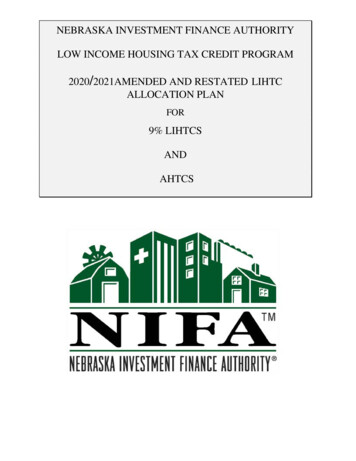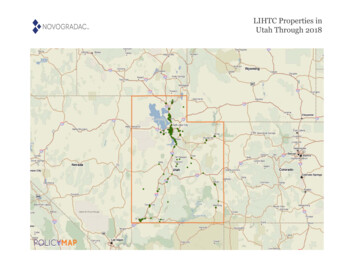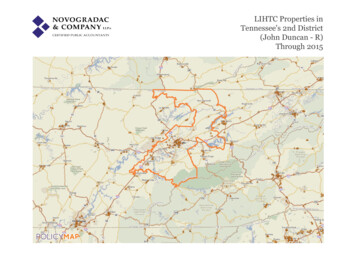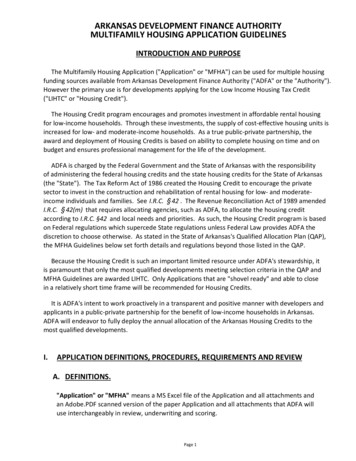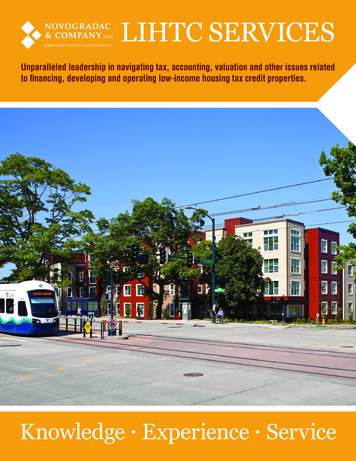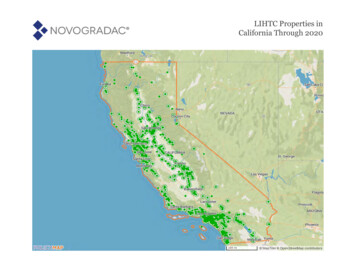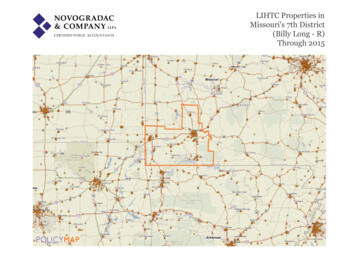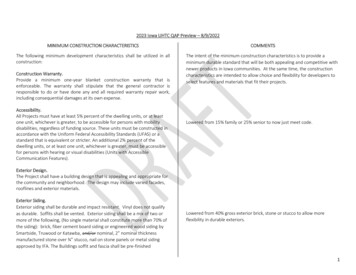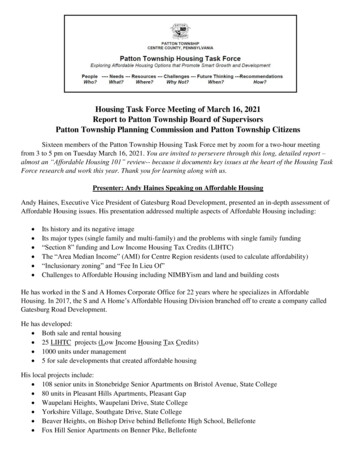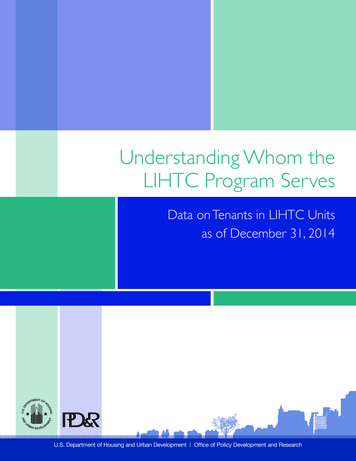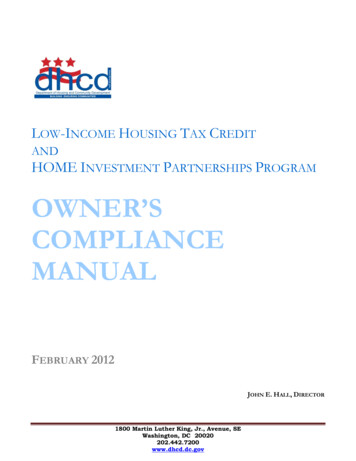
Transcription
LOW-INCOME HOUSING TAX CREDITANDHOME INVESTMENT PARTNERSHIPS PROGRAMOWNER’SCOMPLIANCEMANUALFEBRUARY 2012JOHN E. HALL, DIRECTOR1800 Martin Luther King, Jr., Avenue, SEWashington, DC 20020202.442.7200www.dhcd.dc.gov
TABLE OF CONTENTSTABLE OF CONTENTS . iiFOREWORD . ivWEBSITE, TRAINING AND FORMS. 2A.WEBSITE . 2B.TRAINING . 2C.FORMS . 2LOW INCOME HOUSING TAX CREDIT COMPLIANCE . 3A.INFORMATION TO BE KEPT AT EACH SITE . 3B.IMPORTANT TIME PERIODS . 3C.TAX CREDIT REGULATORY AGREEMENT . 5D.RECORD KEEPING. 5E.PROPERTY STANDARDS . 7F.TAX CREDIT RENT AND INCOME REQUIREMENTS . 8G.INCOME LIMITS . 10H.CALCULATING INCOME . 10I.OVER INCOME TENANT RESTRICTIONS (140% Rule) . 11J.EVICTIONS . 11K.DETERMINING RENTS . 12L.HOUSEHOLD SIZE. 12M. FEES . 12N.CALCULATING UTILITY ALLOWANCES. 13O.TENANT CERTIFICATION ‐ RECERTIFICATION . 14P.VACANT UNIT RULE AND NEXT AVAILABLE UNIT RULE . 15Q.TRANSFER OF OWNERSHIP . 15R.STUDENTS . 16S.MATERIAL PARTICIPATION OF A NONPROFIT ORGANIZATION . 16T.ADDITIONAL SECTION 42 REQUIREMENTS . 17Department of Housing and Community Development (DHCD)Owner’s Compliance ManualEffective February 2012Page ii
U.COMPLIANCE MONITORING REVIEWS . 17V.OWNER REPORTING REQUIREMENTS . 18W. ANNUAL MONITORING FEES . 18X.PROPERTY INSPECTIONS. 18X.“NOTICE TO CURE FILE AND PHYSICAL REVIEW FINDINGS” LETTER. 19Y.ADDITIONAL COMPLIANCE ISSUES . 211. Employee Units . 212. Unit Transfers. . 213. Move out fees, Move out records and fees. 224. Other Federal Compliance. 24Department of Housing and Community Development (DHCD)Owner’s Compliance ManualEffective February 2012Page iii
FOREWORDThe Department of Housing and Community Development (DHCD) is the agency responsible forthe administration and monitoring of Low Income Housing Tax Credits and HOME funds for theDistrict of Columbia. This guide has been developed to assist recipients of Tax Credits and/orHOME funds in maintaining a multi‐family rental property during the compliance and/oraffordability period.This manual is not a substitute for the requirements of Section 42 of the Internal Revenue Code(the Code) as they pertain to Tax Credits or the requirements of 24 CFR Part 92 under the HOMEProgram. Compliance with the IRS and HUD requirements are the sole responsibility of the ownerof any building with Tax Credits or HOME funds.The following documents are important source documents provided by federal agencies forLIHTC and HOME properties:HUD 4350 Handbook* (Chapter 5)IRC Section 42IRS Guide for Completing Form 8823*24 CFR Part 92HUD CPD NoticesHousing and Economic Recovery Act of 2008These documents should be used and available to owner representatives and managementpersonnel.* The Office of Program Monitoring has the latest versions of the 4350.3 HUD handbookand the 8823 Guide posted on the compliance section of DHCD’s website at the following link:http://www.dhcd.dc.Important DisclaimerDHCD’s responsibility to monitor for compliance will not cause DHCD to be liable for an owner’snoncompliance. Therefore, an owner should not rely solely on DHCD to determine if the projectand its records are in compliance. DHCD recommends all Tax Credit and HOME funded recipientsconsult with a tax accountant, attorney, or other professional as to the specific requirements of theTax Credit and the HOME program Federal Regulations.The penalty for failure to adhere to DHCD’s policies may be forfeiture of the right to participatein all DHCD programs in one or more future years depending upon the severity and nature ofthe particular circumstances and/or financial penalties.Department of Housing and Community Development (DHCD)Owner’s Compliance ManualEffective February 2012Page iv
Properties that receive both HOME and Tax Credit funding must adhere to the more restrictiveregulation/requirement of either program.*It is the responsibility of the owner/manager to ensure that they are using the most current version of all programdocuments and forms. Federal Agencies such as HUD and the IRS frequently update materials. DHCD makes everyeffort to post these changes to our website in a timely manner. To keep abreast of all of the changes, theowner/manager should check the HUD, IRS and DHCD websites on a regular basis.Although DHCD acknowledges that properties with other funding sources, such as Tax ExemptBonds, Section 8, Housing Production Trust Fund, etc. must adhere to those regulations, this doesnot release the property from adhering to DHCD’s funding source regulations/policies. The mostrestrictive regulation/rule will always apply.ORGANIZATIONDHCD’s Owner’s Compliance Manual is organized as follows:PART IPART IIPART IIIWebsite, Training and FormsLow Income Housing Tax Credit ComplianceHOME Program ComplianceFormsPlease note: This manual is intended to be used in electronic format. It contains many hyperlinksto DHCD and non‐DHCD websites. As always, users should make sure they are using an up todate security web browser with current anti‐virus software.Department of Housing and Community Development (DHCD)Owner’s Compliance ManualEffective February 2012Page v
PART IDepartment of Housing and Community Development (DHCD)Owner’s Compliance Manual (PART I)Effective February 2011Page 1
Website, Training and FormsA.WEBSITEIn an effort to make information available to participants in the LIHTC and HOME programs asquickly and efficiently as possible, the Office of Program Monitoring (OPM) posts all general andprogram wide notices on the Compliance section of the DHCD website. The internet address is:http://www.dhcd.dc.gov.B.TRAININGOPM is committed to providing training to the participants in the LIHTC and HOME programs.From time to time, workshops are scheduled when major changes or initiatives are announced. Tosee a schedule and list of classes currently offered, go to the DHCD Compliance website listedabove. Training can also be provided for individual companies at a site and time agreed to withOPM.1. Required Training. A representative for the owner/general partner of a funded project isrequired to successfully complete a compliance training provided or sponsored by DHCD or anynationally recognized affordable housing consultant prior to the beginning of lease‐up. The ownerof a Tax Credit or HOME property will be required to submit to DHCD evidence of attendance atthe compliance training prior to the project’s receipt for 8609s.DHCD requires Owners as well as an on‐site Property Management Representatives to attend thiscourse. In the event, DHCD determines that a property is experiencing compliance problems,additional training may be required for Owners, Property Managers or other project representativesas part of the cure for noncompliance.C.FORMSDHCD mandates that certain forms and formats be utilized by program participants. As of the dateof publication, the following forms are mandated by OPM: AFHMP Affirmative Fair Housing Marketing Plan ‐ HOMEAnnual Ownerʹs Certification ‐ LIHTCAnnual Ownerʹs Certification ‐ HOMERequest for Recertification Waiver ‐ LIHTCTenant Income CertificationDepartment of Housing and Community Development (DHCD)Owner’s Compliance Manual (PART I)Effective February 2011Page 2
This list and the forms themselves are subject to updating or change. To ensure that the currentform is being utilized, visit the compliance page on the website at www.dhcd.dc.gov.Failure to use these forms can result in noncompliance and increased scrutiny during DHCDproperty reviews. Penalties can include loss of or ineligibility for future funding.Low Income Housing Tax Credit ComplianceA.INFORMATION TO BE KEPT AT EACH SITEThe following information must be kept at each site. It should be easily accessible to employeesand DHCD representatives and updated as required: Tax Credit Regulatory Agreement 8609(s) – executed first year forms DHCD Application for Funding Property Management Summary (Mandatory Form) Utility Allowance (Current and previous) Income Limits (Current and previous) 4350 HUD Handbook, Chapter 5 Copies of All Advertising (for past 4 years) Tenant Selection Criteria Copies of Company Policy on Reasonable Modification and Accommodation Current Annual Owner’s Certification List of all units that meet Accessibility requirements LIHTC Training Certificate (No more than two (2) years old) Certificates that staff has attended Fair Housing Training Copies of all Applicant Rejection Letters Supportive Services, if anyB.IMPORTANT TIME PERIODSPlease refer to the Code for specific regulations regarding compliance with Section 42requirements regarding credit periods, compliance periods, and extended use periods. The Codealso regulates Termination of Rent and Income Restriction prior to end of Extended Use Period.The applicant’s compliance responsibilities begin with the award of the Tax Credits and willcontinue through the end of the Compliance Period or the Extended Use Period whichever islonger.Department of Housing and Community Development (DHCD)Owner’s Compliance Manual (PART I)Effective February 2011Page 3
The Credit Period (IRC 42(f)) is usually 10 years following the date the building was placed inservice. It is the time period in which the owners of the project receive tax credits, which they canthen apply to their respective income tax liabilities.The Compliance Period (IRC 42(i)(1)) is the duration of the credit period plus 5 years. Thecompliance period is 15 years beginning with the first year of the tax credit period (placed inservice year or subsequent year if deferral was elected).The Extended Use Period (IRC 42(h)(6)(D)) restricts the eligibility of developments to receive anallocation of Tax Credits to only those developments that agree to keep the property income andrent restricted for an extended period of time. The term for this period is a minimum of 15 years inaddition to the normal 15 year compliance period. This results in a total term of compliance periodof 30 YEARS.Minimum Period for DHCD Rent, Income and Occupancy Restrictions. Many projects haveadditional rent and occupancy restrictions as a result of the DHCD scoring process. Theserestrictions remain in effect through the “Compliance Period.”Termination of Rent and Income Restriction prior to end of Extended Use Period. The extendeduse period for any building that is part of the Project shall terminate: On the date the building is acquired by foreclosure or instrument in lieu of foreclosureexcept that for a period of three years following the termination of the extended use period,the Owner shall not evict the tenant of a Low‐Income Unit or terminate the tenancy of anexisting tenant of any Low‐Income Unit other than for good cause and shall not increase thegross rent above the maximum allowed under the Code with respect to any such Low‐Income Unit. On the last day of the one‐year period that begins on the date Owner properly submits awritten request to the DHCD, asking the DHCD to assist in procuring a ʺqualified contract,ʺas defined in Section 42(h)(6)(F), for the acquisition of the low‐income portion of thebuilding, but only if the DHCD is unable to present a qualified contract during such one‐year period; provided, however, such request may not be made before the end of year 14 ofthe compliance period or as agreed to by the Owner in its application.Waiver of Right to Opt Out. As part of its scoring process, some projects have elected to waivetheir right to request a qualified contract from DHCD after the end of year 14 of the CompliancePeriod. Project Owners should review their Applications and recorded Land Use RestrictionAgreements to determine whether there has been such a waiver for the project.Department of Housing and Community Development (DHCD)Owner’s Compliance Manual (PART I)Effective February 2011Page 4
DHCD is required to monitor projects for compliance with the requirements of the Code, therepresentations set forth in the Application, the requirements stated in the QAP, and therequirements set forth in DHCD’s various program manuals. DHCD’s plan for compliancemonitoring described below outlines the overall requirements, offers explanations for individualprogram regulations, and sets forth the requirements for properties participating in multipleprograms.C.TAX CREDIT REGULATORY AGREEMENTDHCD will enforce income, rent and occupancy requirements and agreements throughcovenants running with the property. For all projects allocated Tax Credits, the owner is requiredto execute a Regulatory Agreement for Low Income Housing Tax Credits with DHCD. Thisdocument must be recorded with the local Recorder of Deeds and is a deed restriction that carriesforward to all subsequent owners of the property. When there is more than one financing sourceimposing land use restrictions on a project, e.g., a HOME Loan and Credits, there may berestrictions from one program that are more restrictive than similar restrictions in the otherprogram(s). In such instances, the more restrictive requirements will apply to the project.Extended low‐income housing commitment means any agreement between the owner and DHCDin which the owner agrees to all terms and conditions in regard to the IRS compliance period of 15years, the additional 15 year extended use period. An owner may also make additionalcommitments during the application phase. These commitments may include occupancyrestrictions, structural restrictions, additional rent and income restrictions, single‐family dwellinglease to purchase or that a local public housing authority will sponsor the project. Owners mustadhere to all pledges made during the application phase throughout the compliance and extendeduse periods.The land use restrictions will be enforced by DHCD. The use restrictions will not be removed untilthe agreement has expired.Record Keeping Requirements. DHCD asserts the right to perform an on‐site inspection of tenantrecords on any project receiving Tax Credit funding at any time from initial allocation through theend of the Compliance Period or the Period of Affordability whichever is longer. Copies of tenantrecords of any project receiving credits may be requested at anytime during the compliance period.D.RECORD KEEPING (Treas. Reg. 1.42‐5(b) (1))Under the Tax Credit record keeping provision, the owner of a low‐income housing project mustkeep records for each qualified low‐income building in the project for each year in the complianceperiod:(i)The total number of residential rental units in the building (including the number ofbedrooms and the size in square feet of each residential rental unit);Department of Housing and Community Development (DHCD)Owner’s Compliance Manual (PART I)Effective February 2011Page 5
(ii)(iii)(iv)(v)(vi)(vii)(viii)(ix)The percentage of residential rental units in the building that are low‐income units;The rent charged on each residential rental unit in the building (including any utilityallowances);The number of occupants in each low‐income unit, but only if rent is determined bythe number of occupants in each unit under I.R.C. Section 42(g) (2) (as in effectbefore the amendments made by the Omnibus Budget Reconciliation Act of 1989);The low‐income unit vacancies in the building and information that shows whenand to whom, the next available units were rented;The annual income certification of each low‐income tenant per unit. For an exceptionto this requirement, see I.R.C. Section 42(g)(8)(B) (which provides a special rule for a100 percent low‐income building);Documentation to support each low‐income tenant’s income certification (forexample, verifications of income from third parties such as employers or stateagencies paying unemployment compensation, a copy of the tenant’s federal incometax return, or Forms W‐2 Tenant income is calculated in a manner consistent withthe determination of annual income under Section 8 of the United States HousingAct of 1937 (Section 8), not in accordance with the determination of gross income forfederal income tax liability. In the case of a tenant receiving housing assistancepayments under Section 8, the documentation requirement of this paragraph(b)(1)(vii) is satisfied if the public housing authority provides a statement to thebuilding owner declaring that the tenant’s income does not exceed the applicableincome limit under I.R.C. Section 42(g);The eligible basis and qualified basis of the building at the end of the first year of thecredit period; andThe character and use of the nonresidential portion of the building included in thebuilding’s eligible basis under I.R.C. Section 42(d) (e.g., tenant facilities that areavailable on a comparable basis to all tenants and for which no separate fee ischarged for use of the facilities or facilities reasonably required by the project).Tax Credit Record Retention (Treas. Reg. 1.42‐5(b)(2)). Under the record retention provision, theowner of a Tax Credit housing project is required to retain the records described in Treas. Reg.1.42‐5(b)(1) for at least six years after the due date (with extensions) for filing the federal incometax return for that year. The records for the first year of the credit period, however, must beretained for at least six years beyond the due date (with extensions) for filing the federal incometax return for the last year of the compliance period of the building. Owners must retain first yearrecords for a minimum of 21 years plus DHCD’s requirement of the extended use period.Tax Credit Inspection Report Retention (Treas. Reg. 1.42‐5(b)(3)). Under the inspection recordretention provision, the owner of a low‐income housing project is required to retain the originallocal health, safety or building code violation reports or notices that were issued by the state orlocal government unit. Retention of the original violation reports or notices is not required onceDepartment of Housing and Community Development (DHCD)Owner’s Compliance Manual (PART I)Effective February 2011Page 6
DHCD reviews the violation report or notices and completes its inspection, unless the violationremains uncorrected.DHCD requires that an owner must attach a statement summarizing the violation report or noticeor a copy of the violation report or notice to the annual certification submitted to DHCD. Inaddition, the owner must state whether the violation has been corrected.Electronic Storage (Revenue Procedure 97‐22). This Revenue Procedure outlines the type ofelectronic storage and processes that are acceptable in the Tax Credit Program.E.PROPERTY STANDARDSDHCD inspects LIHTC properties according to Uniform Physical Conditions Standards (UPCS).Please see the following links for /pass/upcd comp list.xlshttp://www.hud.gov/offices/reac/pdf/pass dict2.3.pdfThe LIHTC program does not use a weighted score as in REAC. Deficiencies that are found duringan inspection are reported on IRS form 8823, unless self‐corrected prior to the inspection. DHCDmay also comment on and require, under local ordinances, additional repairs not listed underUPCS guidelines.Tax Credit Properties‐Non‐transient Occupancy and Suitable for Occupancy Requirement(I.R.C. Section 42(i)(3)(B)). A unit shall not be treated as a Housing Credit unit unless the unit issuitable for occupancy and used other than on a transient basis. The suitability of a unit foroccupancy shall be determined under regulations prescribed by the Secretary of the Treasurytaking into account local health, safety and building codes. A unit is considered to be used on anon‐transient basis if the initial lease term is six months or greater. Therefore, owners may meetthis requirement by executing a minimum six month lease with Housing Credit occupants. Theonly exceptions are Single Room Occupancy (SRO) and transitional housing units supported underthe Stewart B. McKinney Homeless Assistance Act. All Housing Credit units must be suitable foroccupancy at all times to be deemed eligible for credit. Owners are encouraged to make periodicinspections of vacant and occupied Housing Credit units utilizing UPCS to ensure that the unitsare suitable for occupancy.General Public Use – (Treas. Reg. 1.42‐9)(a) If a residential rental unit in a building is not for use by the general public, the unit is noteligible for Housing Credit.(b) If a residential rental unit is provided only for a member of a social organization orprovided by an employer for its employees, the unit is not for use by the general public andis not eligible for Housing Credit. In addition, any residential rental unit that is part of aDepartment of Housing and Community Development (DHCD)Owner’s Compliance Manual (PART I)Effective February 2011Page 7
hospital, nursing home, sanitarium, life care facility, trailer park or intermediate care facilityfor the mentally and physically handicapped is not for use by the general public and is noteligible for Housing Credit. The Housing and Economic Recovery Act of 2008 clarifies thegeneral public use test to explicitly allow Tax Credit developments that establish tenancyrestrictions for persons with special need, tenants who are involved in artistic or literaryactivities, and person who are members of a specified group (effective for buildings placedin service before, during and after date of enactment).If DHCD determines that a project does not meet these requirements, it is required to report thenoncompliance and whether or not the problem is corrected to the Internal Revenue Service on IRSForm 8823. Failure to maintain a building will result in the loss of tax credits. All incidents ofnoncompliance will be reported.F.TAX CREDIT RENT AND INCOME REQUIREMENTSMinimum Section 42 Set‐Aside Elections. For every tax credit project, the owner must record arestrictive covenant agreeing to one of the following tax credit set asides (ʺSection 42 Rent andOccupancy Restrictionsʺ):At least 20% of the Units in the Project are and will continuously be maintained as both rent‐restricted and occupied by individuals whose income is 50% or less of Area Median GrossIncome. (If an Owner makes this election, all tax credit units will be rent and income restrictedto 50% or less of Area Median Gross Income).(or)At least 40% of the Units in the Project are and will continuously be maintained as both rent‐restricted and occupied by individuals whose income is 60% or less of Area Median GrossIncome. (If an Owner makes this election, all tax credit units will be rent and income restrictedto 60% or less of Area Median Gross Income).The owner has until the end of the first year of the tax credit period for the building to lease thespecified number of units to eligible low‐income tenants necessary to meet the minimum low‐income occupancy requirements (20 percent or 40 percent based on the minimum percentageelected). For projects consisting of more than one building, low‐income occupancy compliancefor the entire project must be met within this same time period. (Section 42 (g)(3))A property is in compliance if the elected minimum set aside test is met by the end of the first yearof the owner’s credit period and continues to be met throughout the compliance period. In anacquisition and rehabilitation project in which a tenant is living in the unit prior to acquisition andplans to remain in the unit after the rehabilitation is completed, the tenant should be certifiedwithin ninety (90) days of the time of acquisition or loan closing unless the unit is not suitable foroccupancy.Department of Housing and Community Development (DHCD)Owner’s Compliance Manual (PART I)Effective February 2011Page 8
If the project does not meet the minimum set aside by the end of the first year of the credit period,the property does not qualify as a low income housing project and the credit cannot be claimed inany year. Non compliance also occurs if the project falls below the minimum set aside anytimeduring a subsequent year in the compliance period.Elimination of 40/50 Rule. The Housing and Economic Recovery Act of 2008 eliminates below‐market federal loans from the definition of federally subsidized properties, allowing, 9% Credit onall federally subsidized properties, except for tax‐exempt bond financed properties. In suchprojects, there is no longer a requirement for 40% of the units to be leased to households at 50% orless of the Area Median Income (AMI). This change is only effective for buildings placed in serviceafter the date of enactment.Rent, Income and Occupancy Requirements. In an Application submitted by the Owner of aproject, the Owner may make additional representations to DHCD regarding rent, income andoccupancy restrictions which may be more restrictive than those required by Section 42. Theselimitations may include, but are not limited to: Very Low Rent and Income Restrictions where the Applicant agrees to reserve a specifiednumber of units for occupancy by households earning annual gross incomes greater than30%, but less than or equal to 50% of AMI and to set rents for those units at or below 30% of50% of the area gross median income, adjusted for bedroom size. Very, Very Low Applications that propose dwelling units with rents set at the 30% rent leveland reserved for occupancy by very‐very low‐income (those earning annual gross incomesof 30% or less of the AMI). Mixed income projects in which a specified percentage of the units are designated as marketrate units which are not subject to any rent or income restrictions.The use of Project Based Rental Assistance is not prohibited for Very Low and Very, Very Lowunits, but an owner cannot accept PBRA in excess of the applicable restricted rent amount forthose units if points have been received for the deeper targeting. Please refer to HUD 24 CFRPart 983 for new project‐based certificate regulations and to the appropriate year QualifiedAllocation Plan (QAP).These additional rent and income restrictions will be referenced in the Tax Credit RegulatoryAgreement for the project.Minimum Period for Rent and Income Restrictions. Section 42 Rent and Occupancy Restrictionsshall remain in effect throughout the ʺExtended Use Period.ʺ In accordance with Section 42, theExtended Use Period shall commence with the first day in the compliance period on which anybuilding that is part of the Project is placed in service and end
1800 Martin Luther King, Jr., Avenue, SE Washington, DC 20020 202.442.7200 www.dhcd.dc.gov LOW-INCOME HOUSING TAX CREDIT AND HOME INVESTMENT PARTNERSHIPS PROGRAM OWNER'S COMPLIANCE MANUAL FEBRUARY 2012 JOHN E. HALL, DIRECTOR
